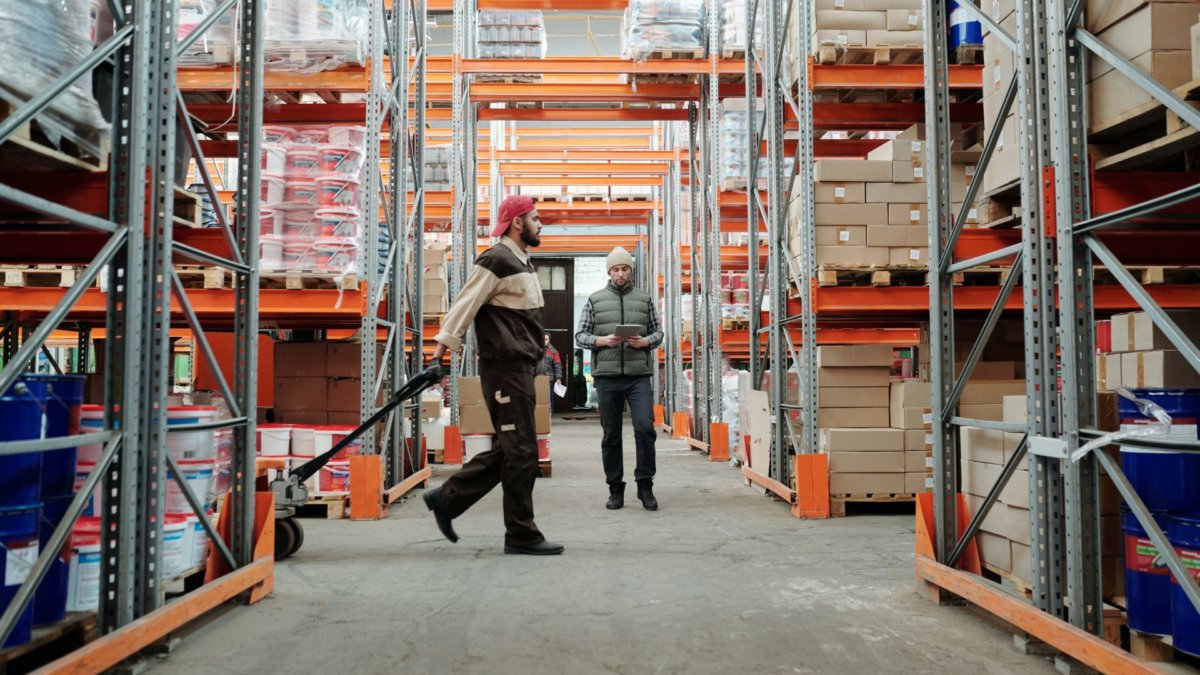
Picking warehouse
22. February 2024
Procurement logistics
23. March 2024What is a distribution warehouse?
A distribution warehouse, also known as a distribution center, is a facility in the supply chain where goods are stored and later distributed to retail stores, wholesalers or directly to customers. These warehouses play a crucial role in managing the flow of goods between manufacturers and end consumers.
Distribution warehouses are usually large and can store products from different suppliers. They are strategically positioned to enable fast and efficient distribution of goods. Tasks in a distribution warehouse can include storage, repacking, sorting, assembling deliveries and sometimes product assembly.
The importance of distribution warehouses in the economy
Here are some specific reasons why distribution warehouses are so important:
- Increased efficiency: distribution warehouses allow companies to ship their products quickly and efficiently. They are often strategically positioned to minimize shipping times.
- Warehousing: They provide space to store products, allowing companies to manage and keep track of their stock. This is particularly important for companies with a large variety of products or seasonal offers.
- Cost reduction: By bundling shipments, distribution warehouses can help to reduce transportation costs. Instead of sending many small shipments directly from the manufacturer to the retailer or customer, goods can be transported in larger quantities to the distribution warehouse and distributed from there.
- Customer satisfaction: With an efficient distribution warehouse, companies can ensure fast and reliable deliveries, which contributes to customer satisfaction.
- Flexibility: Distribution warehouses offer flexibility in terms of changes in demand or supply. They allow companies to react to seasonal fluctuations or unexpected events by storing additional goods or enabling fast deliveries.
The role of distribution warehouses in the supply chain
Distribution warehouses play a central role in a company’s supply chain. They serve as a hub for the storage and distribution of goods and are crucial for the smooth flow of delivery processes.
Process and function of distribution warehouses in the supply chain
The process begins when goods are delivered to the distribution warehouse by manufacturers or suppliers. These goods are then received into the warehouse, often using barcodes or RFID tags for easy identification and tracking.
Once the goods are in the warehouse, they are sorted and stored according to their type, size or destination. This process is also referred to as “receiving”.
When an order for a product is received, this product is taken from the warehouse (a process known as “picking”), packed and prepared for shipment. This process is referred to as “goods issue”.
Contribution of distribution warehouses to the efficiency and speed of goods delivery
Distribution warehouses contribute to the efficiency and speed of goods delivery in a number of ways:
- Strategic positioning: distribution warehouses are often strategically positioned near key markets to minimize transportation distances and enable faster delivery.
- Bundling shipments: Instead of sending many small shipments directly from the manufacturer to the customer, goods can be transported in larger quantities to the distribution warehouse and distributed from there. This saves transportation costs and time.
- Optimized warehouse processes: Distribution warehouses often use advanced warehouse management technologies and systems to optimize putaway, picking and shipping processes. This can help to reduce errors and increase the speed of goods movement.
Different types of distribution warehouses
There are different types of distribution warehouses, each tailored to specific needs and functions within the supply chain.
- Central distribution warehouses: These serve as the main warehouse for a company or organization. They receive goods directly from manufacturers or wholesalers and distribute them to smaller regional warehouses, stores or directly to customers. A central distribution warehouse is usually very large and can store products from a variety of suppliers. It is often strategically positioned to minimize transportation to the various delivery points.
- Regional distribution warehouses: These warehouses serve specific geographical areas. They receive goods from the central distribution center and distribute them to local retail stores or directly to customers in their region. Regional distribution warehouses are smaller than central warehouses, but they are crucial for the fast and efficient delivery of goods to end consumers.
- Cross-docking centers: Cross-docking is a process where incoming goods are prepared for outbound almost immediately, without the need for long-term storage. In a cross-docking distribution warehouse, goods are unloaded from one truck or train and loaded directly onto another truck or train that takes them to their destination. This process minimizes storage time and can help increase supply chain efficiency and reduce costs.
Advantages and challenges of distribution warehouses
Advantages of distribution warehouses
- Improved delivery times: By strategically positioning distribution warehouses, companies can shorten the distances that products have to travel, improving delivery times.
- Reduced transportation costs: Distribution warehouses allow companies to bundle shipments, resulting in lower transportation costs. Instead of sending many small shipments directly from the manufacturer to the retailer or customer, goods can be transported in larger quantities to the distribution warehouse and distributed from there.
- Better inventory control: Distribution warehouses provide a centralized location for storing goods, which allows for more effective inventory control. Companies can more easily track what products they have in stock and when they need replenishment.
- Flexibility: Distribution warehouses offer flexibility to respond to changes in demand or supply. They allow companies to react to seasonal fluctuations or unexpected events by storing additional goods or enabling quick deliveries.
Challenges of distribution warehouses
- Warehouse management: Managing a warehouse efficiently can be a challenge, especially when dealing with large quantities of goods or a variety of product types. This requires the use of advanced warehouse management systems and well-trained staff.
- Inventory control: Maintaining accurate inventory control can be difficult, especially in a hectic warehouse environment. Inventory errors can lead to problems such as overstocking, understocking or lost sales.
Space and resource management: Distribution warehouses require a lot of space and resources. Optimizing space and using resources efficiently can be a challenge. - Security: The security of goods and employees is another concern. Distribution warehouses need to implement appropriate security measures to prevent theft and accidents.
- Sustainability: With the growing focus on sustainability, distribution warehouses face the challenge of making their operations more environmentally friendly. This can include reducing energy consumption, minimizing waste and using more sustainable transportation methods.
Conclusion on the topic of distribution warehouses
In the future, we could see distribution warehouses implementing more and more technological solutions to optimize their operations and increase efficiency. This could include the use of automation, artificial intelligence and advanced warehouse management systems.
In addition, the pressure on sustainability is likely to lead to innovation in the way distribution warehouses are operated. This could include the use of renewable energy, the reduction of waste and the implementation of more sustainable transportation methods.
Overall, the role of distribution warehouses in the supply chain remains vital. Despite the challenges, they offer significant benefits and contribute to the overall performance and efficiency of supply chains.

